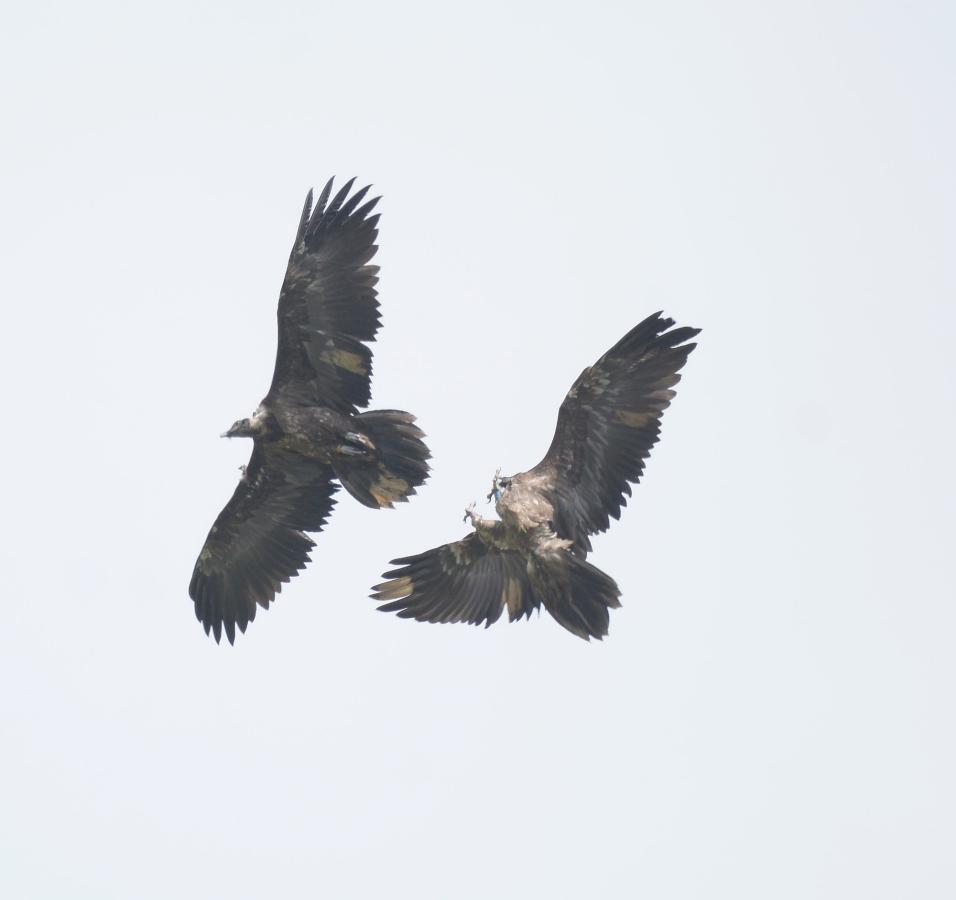Bearded Vulture Obwaldera was released in June this year in Central Switzerland (Melchsee-Frutt) with Bearded Vulture Marco. The release ceremony gathered over 350 participants, eager to see the majestic birds from close! Marco, male, and Obwaldera, female, were taken to the hacking facility, where they spent some weeks preparing for their first flight. Meanwhile, both birds fledged and are in very good shape, often seen flying together. From the laboratory, however, we’ve received quite unexpected news! It seems that, after all, Bearded Vulture Obwaldera is not a female…


Female or male? How can Bearded Vultures be distinguished?
Males and females Bearded Vultures (Gypaetus barbatus) can hardly be distinguished as their physical differences are very subtle. Both have a “beard” and wear “make-up” once they reach adult plumage, a deep orange-red tinge on their plumage that they get from bathing in iron oxid-rich mud. Although females can be larger and heavier than males, a shared characteristic with other raptor species, the difference is barely seen. Therefore, the sex of Bearded Vultures is determined through DNA analysis in the laboratory. As errors can occur, we check the analyses with a second sample and, if necessary, with a third sample.


Bearded Vulture Obwaldera is a male!
The second analysis of Obwaldera’s sample revealed an unexpected result: Obwaldera is a male! The laboratory results are, however, more consistent with Obwaldera’s observed behaviour. Typically, males start their first flights at a very young age, which was the case for Obwaldera. The fact that two males were released in Switzerland this year is not tragic for the ongoing reintroduction project. There are enough females in the wild population, and we are very optimistic that once both reach sexual maturity, they will find a female to pair with.
Marco, when a fearless Bearded Vulture meets a chamois
As with any Bearded Vulture release, the first months of adaptation to their new homes are normally full of surprises, sometimes scary ones. On one rainy morning, before they fledged, Obwaldera was quite active with his flying exercises in the nesting area, whilst Marco was taking a slow morning, laying and resting. In the afternoon, a chamois with its offspring approached the nesting site from below. Marco did not move; at this time, he was not yet able to fly and was probably curious about these new animals visiting him.
Surprised by the sight of an enormous Bearded Vulture staring at them, the chamois suddenly attacked Marco to protect its kid. Marco was strongly hit by the chamois and was projected some meters away, a terrifying moment for the monitoring team following the event in real-time, thanks to the webcams placed in the nest. Would Marco survive the violent confrontation?
The chamois and its offspring moved on. The team prepared all means and the veterinary team to act swiftly in case Marco showed injuries. Surprisingly, Marco is tougher than we could imagine, and after the shock, he continued with his everyday life, getting ready for his first flight.


Obwaldera and Marco are exploring the area
Now that Marco and Obwaldera are circling over Henglirain (Melchsee-Frutt) every day, you have the chance to see them in the wild. Other Bearded Vultures are flying in the area, such as the adult Fredueli and several Griffon Vultures (Gyps fulvus). If you are lucky enough, you can spot a Cinereous Vulture too! More information about the visitor centre can be found here: https://www.bartgeier.ch/auswilderung.


Restoring the Bearded Vulture population in the Alps is a long-term commitment that the VCF and many partnering organisations started in the 1970s. Back then, the Alpine population was extinct, and the first releases of captive-bred Bearded Vultures happened in 1986 in the Hohe Tauern National Park in Austria. It took a decade for the first Bearded Vulture chick to be hatched and reared in the wild! Now, the Alpine population is thriving, but the reintroduction project continues.
Since 2015, Bearded Vulture releases have also occurred in Central Switzerland, aiming to increase the Alpine population’s genetic diversity. Individuals with the rarest genetic types from the Bearded Vulture EEP are, therefore, selected to be released at the heart of the Alps! The releases in Switzerland are only possible thanks to the joint efforts of SPB Stiftung ProBartgeier and the many Zoos and Specialised Breeding Centres within the Bearded Vulture Captive-Breeding Network (Bearded Vulture EEP).
We hope Marco and Obwaldera have a long life in the wild and, in due time, find their life-long females to pair with and produce their offspring in the heart of the Alps.
Source:
https://www.bartgeier.ch/bilderblog/2023/obwaldera-ist-ein-maennchen
https://www.bartgeier.ch/news-bartgeier-unterwegs/ueberraschendes-bei-marco-obwaldera





